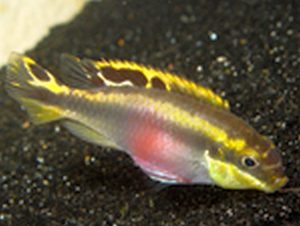The Kribensis (Pelvicachromis pulcher) or “Krib” as many tropical fish keeping enthusiasts call them, is endemic to Nigeria and Cameroon, Africa. Kribs are a popular aquarium species that are sold under various names such as; the common krib, red krib, super red krib, rainbow krib, rainbow cichlid, and purple cichlid
Although some populations of Kribensis have been found in brackish waters, they are more often found in the heavily vegetated still and slow moving waters of their range
Both Kribensis sexes have a dark longitudinal line that runs from the caudal fin to the mouth of the fish. They have pink to red abdomens, and both their dorsal and caudal fins have gold ringed ocelli or eye spots on them. During breeding, the females develop a purple belly and the colors of both sexes become much more intensified. Males are larger than the females and have more pointed pelvic, dorsal, and anal fins. Females are smaller, rounder, and have more rounded dorsal and anal fins. Adult males have a much more elongated and spade shaped caudal fin, and also lack the gold sheen on the dorsal fin.
Kribensis are a shy and retiring species that are often recommended for community tanks, but like all cichlids, they become territorial and mildly aggressive when breeding. They can be housed with other West African Dwarf cichlids but they need enough tank space to set up territories for themselves. They can also be housed with barbs, danios, rasboras, characins, gouramis, Corydoras, and Loricariids.
Although a single pair of Pelvicachromis pulcher can be kept in a 20 gallon tank, they do best in a densely planted aquarium of at least 30 gallons, with a fine gravel or sandy substrate, some rocky caves or clay flowerpots for them to breed and hide among, and some driftwood roots for decoration and shelter.
Give them plenty of potential breeding spots and hiding places.
Kribensis are an easy to breed monogamous cave spawning species that make a great “first fish” for new cichlid enthusiasts.
The best way to obtain a pair is to buy a group of 6 or more juveniles and allow pairing to naturally occur. Set up the breeding tank with plenty of caves and an air powered sponge filter to prevent the fry from being sucked into a power filter. The water should be in the 75-81°F range with a pH of 6.5-7.0.
If the pH is too acidic, the result will be mostly females. If the pH is to alkaline, more males will be the result.
Condition the breeding pair on a diet of live, frozen, or freeze dried bloodworms, brine shrimp, etc.
Spawning should commence when the colors of the pair intensify, especially the female. The female’s belly will turn a deep purple and she will initiate a spawning ritual to entice the male. When ready, the pair will choose a cave to spawn in and up to 300 adhesive eggs will be deposited on the walls or the roof of the cave where they are fertilized by the male. The female tends to the eggs while the male defends the cave against any intruders.
The eggs will usually hatch out in 2 to 3 days. The fry becoming free swimming after another 7 to 8 days. The fry are herded out of the cave en masse and shepherded around the tank by both of the parents. When a singles stray away from the heard, they are rounded up into the mouth of the parents and spit back out into the main group. Both parents provide brood care which lasts from 21 to 28 days.
At this point, some females will turn on their partners, so watch the pair carefully.
Feed the fry newly hatched brine shrimp or microworms, but keep them with the parents until signs of the next spawn are seen, then remove the fry to another system.
Kribensis are easy to feed and will accept most foods. Feed them a quality cichlid pellet and augment their diet with regular feedings of fresh, frozen, or freeze dried tubifex, bloodworms, mosquito larvae, brine shrimp, etc.
Kribensis are readily available to tropical fish keeping enthusiasts in a range of sizes at reasonable prices, or they can be purchased online.
Minimum Tank Size: 30 gallons
Care Level: Easy
Temperament: Peaceful
Aquarium Hardiness: Hardy
Water Conditions: 75-80° F, 0-12°H, pH 5.6-7.5
Max. Size: Males 5″, Females 4″
Color Form: Black, Blue, Red, Gold
Diet: Omnivore
Compatibility: Community or Single species tank
Origin: Nigeria, Cameroon
Family: Cichlidae
Lifespan: 10-15 years
Aquarist Experience Level: Beginner



